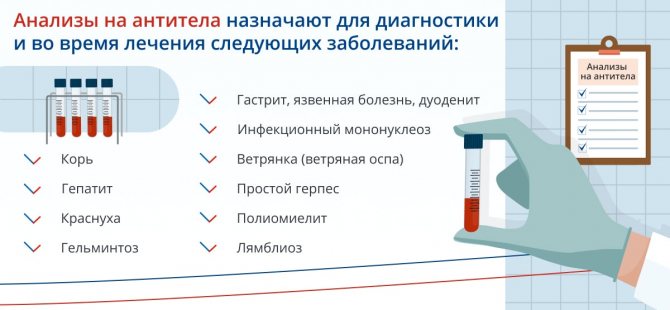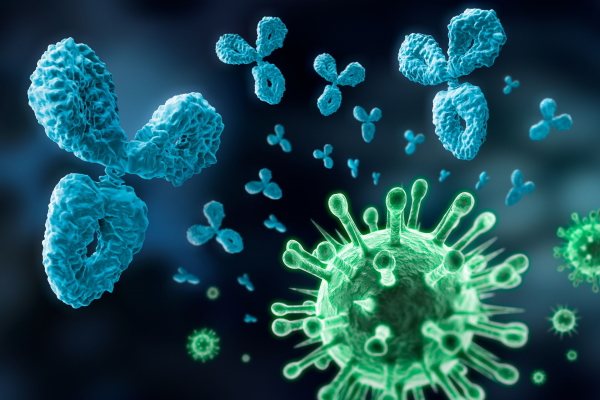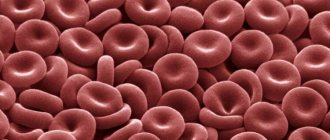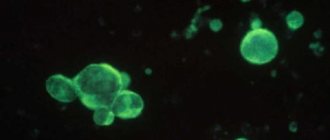Analysis for immunoglobulins Only a specialist can correctly interpret the results of a study of the level of immunoglobulins in the blood. Where can I go?
Increased IgM An increased level of IgM immunoglobulins can be observed, for example, if there is an infection in the body. More details
Increased IgA The level of immunoglobulins of the IgA class can be increased, for example, in acute bacterial infections, liver diseases, and malignant neoplasms. More details
Comprehensive programs Comprehensive diagnostic programs allow you to significantly save on examination. View programs
Examination of the body Modern diagnostic equipment allows laboratory specialists to detect various pathological formations. View the laboratory

The human immune system is a complex system, and antibodies (also known as immunoglobulins) are its irreplaceable protective link. These are special protein molecules that recognize viruses, bacteria and other foreign agents. It is the antibodies that signal the immune cells that it is time to “attack” the intruder. Studying the level of immunoglobulins in the blood allows you to assess the general state of the immune system, diagnose infectious diseases, determine the form of their course, and identify other disorders in the functioning of the immune system. The article contains everything you need to know about antibody testing.
Antibodies as an indicator of the state of the immune system
Special immune proteins, called antibodies, or immunoglobulins, “float” in blood serum and biological fluids, including breast milk. They are produced by B lymphocytes - plasma cells. Immunoglobulins can either be free in the blood or attached to the surface of “defective” cells.
A little history
Antibodies were discovered in 1890 by E. Behring and S. Kitasato while studying the effect of diphtheria toxin on rabbits. It was then that doctors discovered substances that were formed in the blood of animals and could not only neutralize the toxin, but also destroy the diphtheria infection in general.
Having recognized a foreign substance, that is, an antigen, the antibody attaches to it using the so-called protein tail. It serves as a kind of signal flag for specialized immune cells that neutralize the “intruders.”
There are five classes of immunoglobulins in the human body: IgA, IgD, IgG, IgE, IgM. They differ in mass, composition and, most importantly, properties.

IgE and IgD are contained in blood serum in small quantities and have no diagnostic value. The most significant for analyzing the state of the immune system and making a diagnosis are IgM, IgA and IgG.
IgM is an immunoglobulin that the body first begins to produce in response to an “invasion” of infection. It is highly active and stimulates various parts of the immune system. The share of IgM is up to 10% of all immunoglobulin fractions.
Approximately five days after the antigen enters the body, the production of IgG begins (70–75% of the total amount of immunoglobulins). It provides the main immune response. More than half of the antibodies secreted throughout the disease belong to this class.
By the way
Immunoglobulins G are so small that they can pass through the placenta. It is the antibodies transferred to the child from the mother during pregnancy that protect the newborn from various infections in the first months of his life. And the immunoglobulins received by the baby through breast milk support his resistance to infectious diseases throughout the entire feeding period.
IgA is mainly localized in the mucous membranes of the respiratory tract, stomach, intestines and genitourinary system - that is, where pathogens penetrate most often. Immunoglobulins of this class “bind” foreign substances and prevent them from attaching to the surface of the mucous membranes. The share of IgA is 15–20% of the total number of immunoglobulins present in the body.
When can a blood test for antibodies be prescribed?
Information about the concentration of antibodies to pathogens of a particular infection helps to make a diagnosis, determine the level of immunity after vaccination, and detect hidden diseases.

An analysis for immunoglobulins of a certain class can be prescribed for sepsis, rheumatoid arthritis, liver cirrhosis, oncology, chronic purulent otitis media, meningitis, pneumonia and sinusitis, myeloma, HIV infection.
The study is also relevant for identifying disturbances in the functioning of the immune system, including the detection of autoimmune diseases.
If infertility is suspected, a test for antisperm antibodies or antibodies to a hormone called human chorionic gonadotropin, which normally begins to be produced when pregnancy occurs, may be prescribed. During pregnancy, a test for antibodies to the Rh factor is also carried out.
Preparation for the study and blood donation procedure
Tests for antibodies to viruses and other infectious agents are carried out only as prescribed by a doctor.
Blood for antibody tests is donated on an empty stomach. The biomaterial is collected from a vein. For some time before the study, it is advisable for the patient to avoid emotional overload, not engage in heavy physical work, not go to the gym and not drink alcohol. You do not need to follow any special diet before taking the test, but a few days before the test it is better to exclude highly allergenic foods (honey, peanuts, citrus fruits) from your diet.
The essence of the study
The level of immunoglobulins is examined using immunofluorescence analysis, or ELISA. A small amount of blood serum and purified antigen is placed on the surface of a special tablet. An antigen and an antibody of the same type fit together like a key to a lock and form a special immune complex. After this, a substance is added that stains the immune complex. The intensity of the color determines the concentration of immunoglobulins in the serum.
The ELISA method is sensitive even to small amounts of immunoglobulins and has high specificity. This means that the research results will be reliable and accurate.
The study usually takes one to two business days. Some laboratories are ready to provide an urgent result within two to three hours, but the cost of such an express analysis will be approximately twice as high. But more on that later.
Preparing for a blood test
Blood is drawn from a vein in the morning on an empty stomach. If the procedure is performed at another time, the interval after eating should be at least 3-4 hours. On the eve of the study, it is recommended to refrain from drinking alcohol and excessive stress on the body. A few days before blood sampling, the doctor recommends that you stop taking medications that may affect the test results.
It is recommended not to smoke in the last 3 hours before donating blood. Blood is drawn from the ulnar vein. Biological material is stored and transported in sealed tubes at an air temperature of +2 to +4° C. Research results can be obtained within 24 hours. They are interpreted by doctors at the Yusupov Hospital.
Interpretation of antibody test results
Only a doctor can correctly interpret the results of an immunoglobulin test. It takes into account not only the indicators in the study form, but also the patient’s condition, the presence or absence of symptoms of the disease, and data from other studies.
Each laboratory uses its own test systems, therefore the results of tests carried out in different diagnostic centers may vary. The limits indicated below are indicative.
IgA
Total IgA standards for children:
- up to three months - from 0.01 to 0.34 g/l;
- from three months to a year - from 0.08 to 0.91 g/l;
- from one to 12 years:
- for girls - from 0.21 to 2.82 g/l;
- for boys - from 0.21 to 2.91 g/l.
Standards for immunoglobulin A levels for women:
- 12–60 years – from 0.65 to 4.21 g/l;
- over 60 years old - from 0.69 to 5.17 g/l.
Class A antibody concentration standards for men:
- 12–60 years old - from 0.63 to 4.84 g/l;
- over 60 years old - from 1.01 to 6.45 g/l.
The content of IgA in the blood increases during acute and chronic bacterial, including parasitic, infections, malignant neoplasms, lymphomas, systemic connective tissue diseases, cystic fibrosis, liver damage and other rarer pathologies. Also, antibodies of this type can be actively produced in autoimmune diseases.
A decrease in the concentration of antibodies occurs in atopic dermatitis, some diseases of the blood and lymphatic system, including congenital and acquired immunodeficiency conditions. And also in case of disruption of the synthesis of protein molecules, their excessive loss in the urine in kidney diseases and while taking certain medications.
IgM
The IgM content in the blood serum of newborns should be in the range of 0.06–0.21 g/l.
For children:
- from three months to a year:
- for girls - from 0.17 to 1.50 g/l;
- for boys - from 0.17 to 1.43 g/l;
- from one to 12 years:
- for girls - from 0.47 to 2.40 g/l;
- for boys - from 0.41 to 1.83 g/l.
For women - from 0.33 to 2.93 g/l.
For men - from 0.22 to 2.40 g/l.
IgM increases with inflammation, pneumonia, sinusitis, bronchitis, intestinal and stomach diseases and other infections in the acute stage. If the concentration indicator goes beyond the upper limit of normal, this may indicate liver damage, parasitic diseases, autoimmune pathologies, cystic fibrosis, as well as myeloma and lymphocytic leukemia. A decrease in IgM levels is observed with disorders of protein synthesis or damage to the immune system. This often happens after removal of the spleen, significant loss of protein in the urine, during treatment with cytostatics and other drugs that suppress the immune system, with lymphoma, as well as with some congenital immunodeficiency conditions.
IgG
Unlike previous immunoglobulins, IgG levels fluctuate less throughout life.
For women, its norms are:
- at the age of up to a month - from 3.91 to 17.37 g/l;
- from a month to a year - from 2.03 to 9.34 g/l;
- at the age of one or two years - from 4.83 to 12.26 g/l;
- after two years - from 5.52 to 16.31 g/l.
For the strong half of humanity:
- at the age of up to a month - from 3.97 to 17.65 g/l;
- from a month to a year - from 2.05 to 9.48 g/l;
- at the age of one or two years - from 4.75 to 12.10 g/l;
- after two years - from 5.40 to 16.31 g/l.
IgG concentrations may increase in chronic infections, autoimmune diseases, parasitic diseases, sarcoidosis, cystic fibrosis, liver damage, myeloma, chronic lymphomas and lymphocytic leukemia, infectious mononucleosis and granulomatosis. Also, the content of antibodies of this class usually increases with multiple sclerosis, neurosyphilis and AIDS.
The level of IgG may decrease with oncology of the hematopoietic and lymphatic systems, with muscular dystrophy and some other diseases.
But, for example, with HIV infection, the level of IgG can be both extremely high and extremely low - it all depends on the stage of the disease and the state of the immune system.
It is important
To determine the amount of antibodies to COVID-19, you can also take an immunofluorescence test. In this case, the test will show the presence of immunoglobulins M and G. And if, for example, the level of IgM is below 1 g/l, and IgG - up to 10 g/l, then this means that the person has not encountered the virus. And in the case when the content of class M antibodies is below 2 g/l, and class G is higher (or equal) to 10 g/l, it can be assumed that the subject has had a coronavirus infection[1].
Rh antibodies
With the indicators of antibodies to the Rh factor, everything is a little simpler. Normally they should not exist[2]. If antibodies are detected, it means that immunization occurred during a previous pregnancy or through a transfusion of donor Rh-positive blood.
Autoantibodies
These antibodies are also absent in the blood of a healthy person. Their presence indicates the development of autoimmune diseases, when the immune system attacks its own tissues, most often connective, muscle, cartilage, serous, and vascular walls. Thus, the level of these immunoglobulins can increase in rheumatoid arthritis, multiple sclerosis, vasculitis, type 1 diabetes mellitus, scleroderma, systemic lupus erythematosus, psoriasis and others.
Is it possible to get sick again if you have antibodies?
The issue has not been fully studied. The most popular point of view, which doctors tend to favor and which is confirmed by medical practice, is that a person who has been ill can feel relatively calm for 2-3 months after recovery. It is during this period that the immune potential is almost 100% likely to be sufficient to repel the attacks of SARS-CoV-2. Then everything depends on the resistance to the disease of the particular organism.
More and more cases are being recorded where a relapse of COVID-19 is diametrically opposed to the first experience. That is, in case of severe disease, re-infection will be easily tolerated and vice versa.
How much does an antibody test cost?
There are a huge number of types of tests for detecting antibodies. There is, for example, a comprehensive analysis for TORCH infections (toxoplasma, rubella, cytomegalovirus, herpes simplex). It must be taken when planning a pregnancy - such a test will cost from 2000 to 4000 rubles. For an antibody test to the Rh factor, you will have to pay approximately 450–600 rubles.
Testing for antibodies to certain infections costs from 500 rubles. It is difficult to indicate the upper limit of the price range - everything depends primarily on what specific pathogen we are talking about. It is worth considering that the determination of the same IgG and IgM are two different studies, each of which will need to be paid for separately. Thus, a blood test for class G antibodies to coronavirus will cost from 2000–2500 rubles, and a test for immunoglobulin M to COVID-19 will cost from 1500 rubles.
To determine the level of antinuclear (antinuclear) antibodies you will have to pay about 1000 rubles, antisperm antibodies - about 1300 rubles, an analysis for antibodies to thyroglobulin and thyroid peroxidase to detect autoimmune diseases of the thyroid gland costs about 900 rubles.
You also need to include about 150–200 rubles in expenses for drawing blood.
What are antibodies to coronavirus

Antibodies are special proteins - immunoglobulins. This word is complex and comes from two words: “immuno-”, which means belonging to the immune system, and “globulins” - from the Latin “globula”, translated as “ball”.
The structure of proteins belonging to the class of immunoglobulins is unusual. They consist of a hinged and variable part. The second is responsible for attaching an antibody to a particular antigen.
Why are antibodies not immediately formed during illness?
To create the right antibody, the immune system first needs to study the offender. To achieve this, different “departments” cooperate in the body. First, interceptor cells (macrophages) absorb and digest foreign particles. Then they are introduced to their structure of “laboratory” cells (B-lymphocytes). They, in turn, form many copies of themselves with different variants. The “memory” of immunity is not based on antibodies alone. Cells also have it. Lymphocytes that produce antibodies remain dormant until they encounter the pest again. At the right moment, they can quickly create new “shells”. True, such preparation also has a downside, which prevents the creation of effective vaccines against some viruses.
When faced with a familiar virus, the body first throws into battle the cells that were trained to attack it. He suspends the development of new antibodies to save energy. But the virus can mutate in such a way that its vulnerabilities are protected, and the immune system does not recognize this. Even worse: the virus can use the antibody attached to it to enter an immune cell and infect it.
How to decipher the IgM/IgG test for the SARS-Cov-2 virus
Ig M (+) detected, IgG (-) not detected:
With a high degree of probability, we are talking about the presence of an acute infection in the body, especially if there are already signs of the disease.
It is worth considering that in chronic diseases a false positive result occurs.
In case of such an analysis result, it would be advisable to submit a throat swab for testing using the PCR method. If it shows a negative result and there are no signs of illness, then just in case it is better to repeat the antibody test in a couple of weeks.
IgM (+) detected, IgG (+) detected:
The most common result for an ongoing infection is in the early recovery phase. It is also possible that the disease was suffered very recently.
IgM (-) not detected, IgG (+) detected:
It is highly likely that the patient has had COVID-19 previously.
IgM (-) not detected, IgG (-) not detected:
We have already mentioned this option - the absence of antibodies. Most likely, the patient simply has not encountered the virus yet, and his body does not know what it is.











